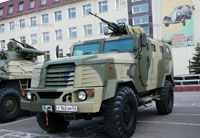Russian Defense Industry To Unveil Striking Novelties
Russia’s Defense Minister Anatoly Serdyukov attended the presentation of IVECO’s armored weaponry in Italy. After the presentation the official said that Russia was planning to organize the production of LMVs – Light Multirole Vehicle – the vehicles that bear a striking resemblance to US Hummers, GZT.ru website said.

It seems that the Russian military command intends to continue purchasing arms from other countries, which raises concerns with many observers. They say that such a trend would be extremely detrimental to the domestic defense industry.
Russia’s renowned KamAZ purchased two LMVs two years ago and then tested them in the Moscow region. A source at KamAZ Corporation confirmed that they were discussing an opportunity to arrange the assembly of LMVs in the city of Naberezhniye Chelny.
Russia Today: Russian navy on course to buy Mistral ships
“Under modern conditions, such assembly works can be arranged in three or four months. A hundred-percent localization will obviously take several years,” the source said.
An official of Russia’s ground forces said that the LMVs could be used to accompany cargo transportations in hotspots and to defend servicemen against automatic fire attacks. The LMVs can protect the crew from land mines on the roads of the Caucasus. Russia’s GAZ-2330 Tiger vehicles are not outfitted with armored capsules made of special light armor, which suffers no damage in case a vehicle runs over a land mine. A mine explosion destroys the salon and the running gear of the Tiger. The crew, if survive, remain blocked in the vehicle as the living target, experts say.
In the meantime, the maker of Tigers said that they were very surprised about such views regarding their vehicles.
“The Tiger has the fifth class of protection. The vehicle can stand a direct attack from any type of small arms. As far as we know, Tiger’s glass is much stronger than that of LMVs. The Tiger is three times less expensive, but its engine is much more powerful. The Russian vehicle has a 420 horsepower engine, whereas the Italian one has a 185 hp engine,” a spokesman for the company said.
The average cost of one LMV is 300,000 euros. This money would be enough to enhance the protection of the Tiger. The glass and the armor of the vehicle would be able to stop hard-target bullets fired from sniper guns. It would also be possible to make the salon more comfortable and outfit the Tiger with auxiliary types of weapons and communication systems.
The adversaries of the production of LMVs in Russia say that Italy would be able to stop the deliveries of spare parts for political reasons.
Those who support Serdyukov’s initiative say that the issue of purchasing arms from abroad must be based on the interests of the army rather than the defense industry. They claim that the Italian vehicles are better than the Russian ones from the point of view of comfort and quality.
In addition to armored vehicles, Russia considers an opportunity to purchase other types of military hardware from foreign countries. Defense Minister Serdyukov said that Russia was conducting negotiations with France, the Netherlands and Spain to purchase Mistral helicopter carriers for the Russian navy.
“The president decided we should elaborate the issue. I think that it will be solved positively if finance or other problems do not occur,” Anatoly Serdyukov said. “We plan to sign the contract for four vessels. One of them will be built abroad, and three others will be built with the participation of Russian specialists. The forth one will be built entirely in Russia,” the minister added.
“Russia’s Northern and Pacific fleets need the Mistral to defend the Kurile Islands and Kaliningrad, if necessary,” deputy defense minister Vladimir Popovkin said.
Russia also had to purchase unmanned aircraft from abroad. Defense Ministry officials acknowledged that Russian air drones were no competition to foreign analogues. Russia spent the total of five billion rubles on the development and tests of the domestic drones, but the tests ended unsuccessfully.
As a result, Sergey Chemezov, the director of state-run Rostechnologies Corporation stated in April that the defense ministry had purchased 15 unmanned aircraft from Israel.
In the meantime, Russia successfully continues to design state-of-the-art military hardware too. The nation’s missile troops received the first group of the new multi-stage missile complex RS-24 Yars. The system is capable of carrying up to four nuclear warheads. It will gradually replace powerful, albeit outdated RS-18 Stilet and RS-20 Satan complexes. The missile troops will also have the new upgraded version of the renowned Topol-M system.
As for the navy, Russia continues working on fourth-generation Borei class submarines complete with Bulava-30 missiles. The test launches of the Bulava ballistic missile have been unsuccessful so far, but Russia is determined to take the tests of the missile to its end. The navy will also receive surface vessels, particularly Project 20380 corvettes.
Russia also works on Su-35 and Su-34 fighter jets, Ka-52 Alligator and Mi-28H Night Hunter helicopters, as well as Yak-130 training aircraft. Russia’s fifth-generation fighter jet will be ready for service in 2015.
In five years, the Russian defense industry will finish the projects of six new missile defense complexes. It goes about the Morfei complex, which can down targets at ultralow altitudes, the medium-range Vityaz system and, of course, the widely advertised S-500 system.
Subscribe to Pravda.Ru Telegram channel, Facebook, RSS!




